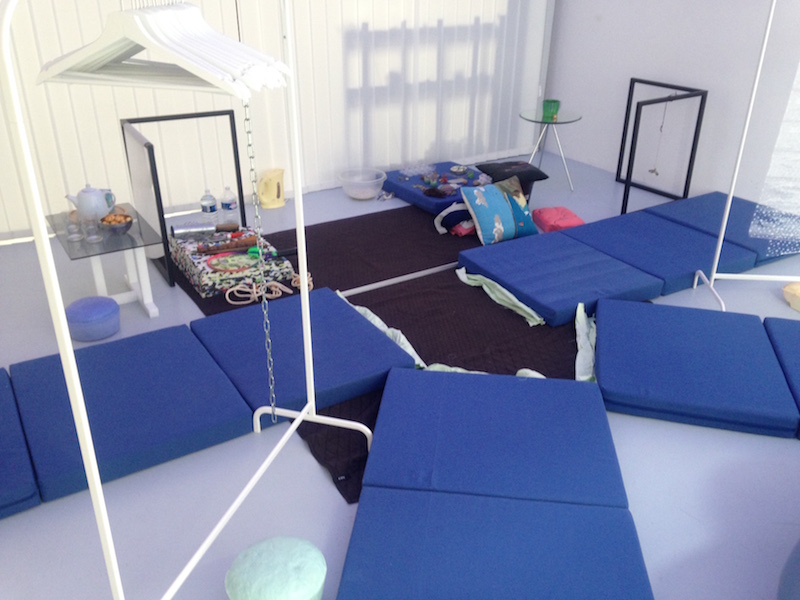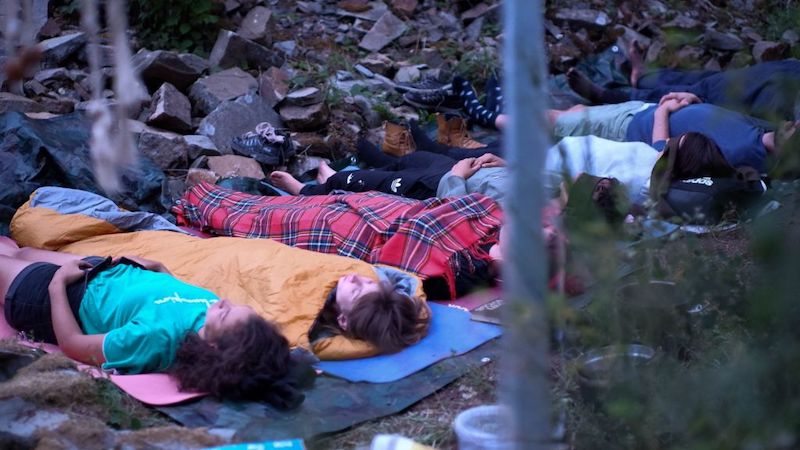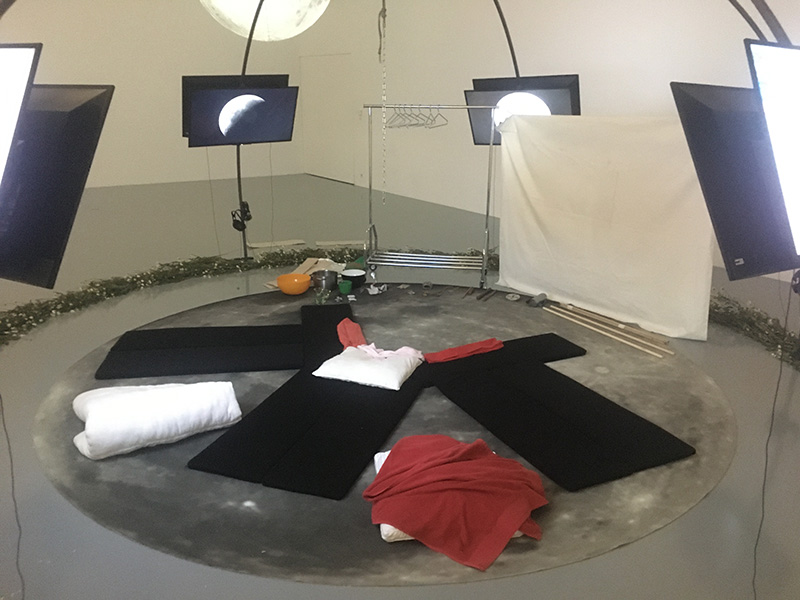What is acousmatic massage ?
Acousmatic massage is a "sound bath" experience proposed by Irmã Ensemble, a collective of sound artists based in Brussels, Belgium.
In other words, acousmatic massage is a sensory immersion through musical listening and tactile perception, without recourse to vision and in consciousness.
This sound and tactile experience take the audience on a multi-faceted journey: letting go, introspection, soundscapes, sensory immersion, auditory and tactile perceptions.
This sensory immersion is mainly created through the spatialisation of a 3D sound environment combined with the use of delicate objects that are placed on the body while the audience is lying down.
📀

Why you should try:
Acousmatic massage is a unique experience in the vanguard of experimental music sensory experiences.
Irmã Ensemble is a fast-growing collective since it receives extensive support from IRCAM, one of the world's leading experimental music centres, based in Paris.
Acousmatic massage differs from sound massage, which in fact uses only Tibetan bowls and gongs, whereas the auditory experience can be extensively enriched by any type of sound and not remain focused on a so-called traditional experience that is not always used in the West for the right reasons.
It's an experience that draws its audience into a moment of letting go, of immersion and sensory perceptions that are rich and introspective, and multiple soundscapes.
📀

who is Irmã Ensemble ?
Since 2018, Laurent Isnard has been bringing together sound artists with a particular interest in sound performance, musical improvisation and sensory perception.
Irmã Ensemble is a variable-geometry collective based in Brussels also connected to France and Brazil due to some of its members. Each member works whether in the field of experimental and contemporary music, live performance or immersive practices and well-being.
📀

is acousmatic massage suitable for you?
Acousmatic massage is a safe experience open to everyone.
However, some people are less keen on sound or body experiences, but we can definetely guarantee that it worth it!
Besides, there are no high intensity sounds or sudden gestures, the movements are extremely delicate and smooth.
Moreover, each member of the ensemble has a strong focus on the inclusion of people from minorities and marginalised groups.
📀

how does it work in the end?
Guidelines and instructions are given at the beginning of each session.
Everyone is invited to close their eyes and take a time for a short time of listening and deep breathing.
After a few minutes, everyone is guided into the room to lie down on a mattress.
Basically Irmã Ensemble combines four layers throughout the performance:
- Ready-made sound effects, moving around.
- Delicate objects for the sense of touch.
- An experimental music improvisation.
- A 3D sound piece travelling through six surround speakers.
📀

where does it take place?
The performance takes place in a space that can accommodate up to thirty people lying down. The room is comfortable and warm and as far away from noise pollution as possible.
Mattresses are laid out in a star shape on the floor, allowing the performers to move easily between everyone.
Irmã Ensemble has performed in various places, mainly interior rooms but also outdoors in the countryside. One notable spot for its acousmatic characteristics is a scree pit based near Namur in Belgium.
📀

how long does it take?
Total duration is 1h30, including presentation and guidelines, the session itself and a time for socialising at the end. We take the opportunity to share our feelings over a cup of tea.
📀

differences between individual and collective sessions:
Irmã Ensemble only takes part in the collective sessions which include a groupe of sound artists, a 3D surround sound system and music improvisation. Those sessions mainly take place in Brussels but also in Paris and abroad during art residences and tours.
One to one sessions are offered by Laurent Isnard at his studio in Brussels, and are strictly acoustic, with no use of any sound system. Despite the fact that those sessions seem technically reduced, its sensory intensity remains strong and somehow perceptions are increased from the privelege of being alone.
📀

book a session
Collective sessions can be reserved at any time by an existing group of people, like friends visiting Brussels, family members, a works council, employees/collaborative team, students, etc. In that case, booking can be personalised and adjusted on a case-by-case basis. For instant booking, please send a message via whatsapp.
Collective sessions are also regularly organised and accessible through our booking application or our events partners. Please check out more on our agenda.
Individual sessions are also proposed all year long by Laurent Isnard at his studio in Brussels. To reserve an individual session at any time, send a message via whatsapp.
📀

For those who want to dig deeper 👇
how we spatialise sound?
The spatialisation of sound takes place first of all at an acoustic level, through the moving manipulation of sound objects around people and the coordination of their movements.
This apparent choreography unfolds silently, gradually blurring the spatial cues of the space.
In turn, the sounds produced by the acoustic instrumentation move towards or away from the people, creating a dynamic, ambisonic (three-dimensional) soundscape.
In addition, a set of eight loudspeakers broadcast a sound ambience made up of a multitude of sounds, sound effects and atmospheric layers, propagating from one loudspeaker to the next.
📀

what sort of sound effects?
Like film sound effects, acousmatic massage uses everyday objects, materials, utensils and dismantled parts, all with a touch of originality and ingenuity.
Most of the objects are salvaged, found in the street, at a flea market or on a building site.
They are methodically collected for their sonic characteristics and for their ability to displace the origin of their nature, to disorientate the identification and recognition of their function.
The objects are combined, manipulated by rubbing, sliding, friction or percussion, to give them their own timbre and identity.
📀

what does tactile sensation mean?
Acousmatic massage is also about tactile sensations, produced by the artists using a range of soft, silky textiles, fluffy objects, abstract shapes, mixed textures, thick fabrics and seed-filled bags.
Entire sequences are devoted to tactile perception. The objects are placed on the body, sometimes brushing against it, creating a warm, reassuring or almost imperceptible sensation, encouraging a connection with oneself and one's body, making the experience even more immersive.
At the time of booking, members of the public are given an outline of the session and the various instructions. This procedure enables a personal evaluation of the relationship to touch, validating the registration, as tactile sensitivity varies greatly from person to person.
📀

music improvisation
A key moment for the musicians, musical improvisation is based on an experimental practice of the instrument, characterised by abstract and noisy sound effects, propagating from one loudspeaker to another and manipulated by small electronic and technological machines.
The improvisation is a moment of exchange and dialogue between the artists, a free and narrative score, a unique and singular experience each time, where the sounds blend in a crescendo towards a gentle agitation and slow down towards a more meditative atmosphere.
3D surround sound system
A set of six loudspeakers broadcast a sound ambience made up of a multitude of sounds and atmospheric layers that propagate from one speaker to the next.
These recordings are the result of editing, synthetic sound effects and natural sound recordings.
These compositions bring together a large number of individual sound tracks, programmed for highly spatialised diffusion.
more about inclusion:
At a time when the inclusion of people from minority groups is improving, i.e. women, LGBTQIA+, racialised or disabled, it seems clear that this work of inclusion must continue at all levels, both within the team and in relation to its audience. This awareness and legitimisation are all the more important in artistic circles, which are media for mediation and performance.
Irmã Ensemble is part of this inclusive approach and wishes to report on its commitment, both as an example and to raise awareness among its peers and target audiences.